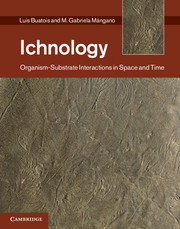1 - The basics of ichnology
from Part I - Conceptual tools and methods
Published online by Cambridge University Press: 25 October 2011
Summary
These "-ichnial" ethologic categories are useful tools for organizing important paleoecologic information about a particular organism community. Of course, semantic distinctions between the different categories may be carried to the extreme, and confusion rather than clarification results. For example, imagine the trackway created by a man running across a mudflat at low tide. Do his footprints represent repichnia (perhaps he was jogging for his health) or fugichnia (perhaps he was being chased by someone with harmful intentions) or praedichnia (perhaps he was chasing sea gulls for a special gourmet dinner)? Imagine that the man fell flat on his face in the mud. If he got up and continued his journey, the impression he left behind would be a cubichnial trace. If, on the other hand, he died where he fell and his body decayed away totally, the remaining impression would be a body fossil (i.e., external mould) and not a trace fossil at all!
Tony Ekdale “Paleoecology of the marine endobenthos” (1985)Ichnology involves the study of traces produced by organisms (both animals and plants) on or within a substrate, and includes all issues related to bioturbation, bioerosion, and biodeposition (Pemberton et al., 1992a; Bromley, 1990, 1996). As such, ichnology encompasses both the study of processes, and their resulting products. The processes are all those involved in the interaction between organisms and substrates. The products are the traces themselves, which comprise individual and distinctive structures of biogenic origin, particularly those related more or less directly to the morphologies of the producers (Frey, 1973), and any sedimentary fabric resulting from biogenic reworking of the substrate, including non-discrete mottlings (i.e. biodeformational structures). Ichnology comprises two main fields: neoichnology (the study of modern traces or lebensspuren of classic German papers) and paleoichnology (the study of their fossil counterparts: trace fossils or ichnofossils). In this chapter, we review the conceptual framework of ichnology. We start by introducing basic concepts and outlining the 10 most important characteristics of trace fossils. Then we discuss aspects of trace-fossil preservation, including different schemes to classify biogenic structures in this respect. Finally, we turn our attention to the potential of trace fossils as sources of behavioral information, providing an in-depth discussion of the ethological classification.
- Type
- Chapter
- Information
- IchnologyOrganism-Substrate Interactions in Space and Time, pp. 5 - 24Publisher: Cambridge University PressPrint publication year: 2011
- 1
- Cited by



